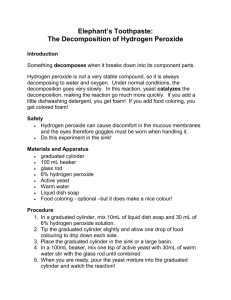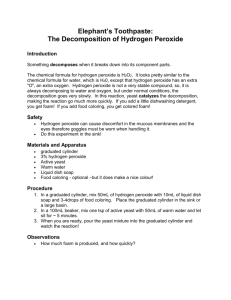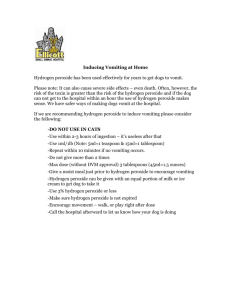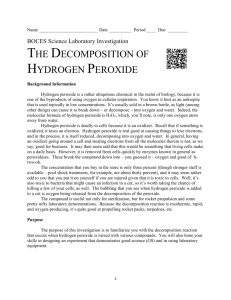Teachers version: Elephant`s Toothpaste
advertisement
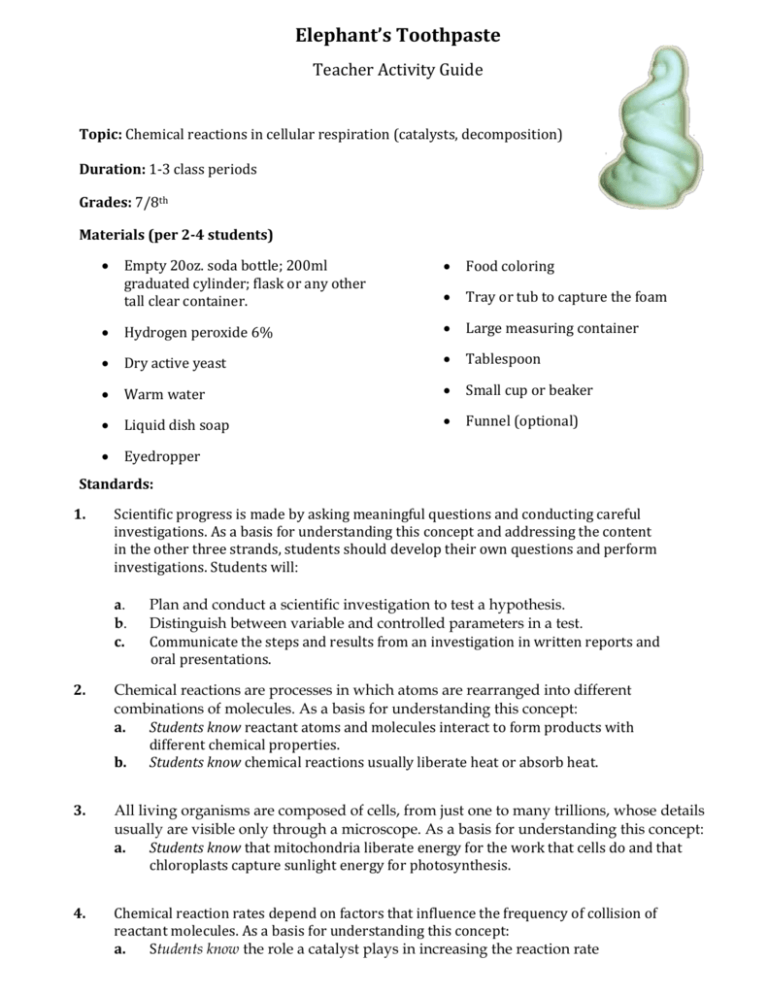
Elephant’s Toothpaste Teacher Activity Guide Topic: Chemical reactions in cellular respiration (catalysts, decomposition) Duration: 1-3 class periods Grades: 7/8th Materials (per 2-4 students) Empty 20oz. soda bottle; 200ml graduated cylinder; flask or any other tall clear container. Food coloring Tray or tub to capture the foam Hydrogen peroxide 6% Large measuring container Dry active yeast Tablespoon Warm water Small cup or beaker Liquid dish soap Funnel (optional) Eyedropper Standards: 1. Scientific progress is made by asking meaningful questions and conducting careful investigations. As a basis for understanding this concept and addressing the content in the other three strands, students should develop their own questions and perform investigations. Students will: a. b. c. Plan and conduct a scientific investigation to test a hypothesis. Distinguish between variable and controlled parameters in a test. Communicate the steps and results from an investigation in written reports and oral presentations. 2. Chemical reactions are processes in which atoms are rearranged into different combinations of molecules. As a basis for understanding this concept: a. Students know reactant atoms and molecules interact to form products with different chemical properties. b. Students know chemical reactions usually liberate heat or absorb heat. 3. All living organisms are composed of cells, from just one to many trillions, whose details usually are visible only through a microscope. As a basis for understanding this concept: a. Students know that mitochondria liberate energy for the work that cells do and that chloroplasts capture sunlight energy for photosynthesis. 4. Chemical reaction rates depend on factors that influence the frequency of collision of reactant molecules. As a basis for understanding this concept: a. Students know the role a catalyst plays in increasing the reaction rate Learning objectives: Students will perform an experimental investigation. Students will make predictions and observations, and answer questions related to chemical reactions. Recognize the importance and ongoing nature of various chemical reactions in the body and discuss cellular respiration. Teacher notes: What is hydrogen peroxide? Hydrogen peroxide is a colorless liquid at room temperature with a bitter taste. Small amounts of gaseous hydrogen peroxide occur naturally in the air. Hydrogen peroxide is unstable, decomposing readily to oxygen and water with release of heat. Although nonflammable, it is a powerful oxidizing agent that can cause spontaneous combustion when it comes in contact with organic material. Hydrogen peroxide is found in many households at low concentrations (3-9%) for medicinal applications and as a clothes and hair bleach. In industry, hydrogen peroxide in higher concentrations is used as a bleach for textiles and paper, as a component of rocket fuels, and for producing foam rubber and organic chemicals. The chemical symbol H2O2 for hydrogen peroxide is very similar to water’s H2O. Hydrogen peroxide molecules are very unstable and naturally decompose into water and oxygen gas. The chemical equation for this decomposition is: 2 H2O2 2 H2O + 02 The equation above represents two hydrogen peroxide molecules decomposing into two water molecules and one oxygen molecule (note that all oxygen gas molecules are comprised of two oxygen atoms – ozone, by contrast, is comprised of three oxygen molecules and has the chemical symbol O3). The decomposition of hydrogen peroxide also releases a small amount of heat so the reaction is exothermic. Hydrogen peroxide is stored in opaque plastic or brown glass bottles to minimize exposure to light which accelerates the natural decomposition of hydrogen peroxide. Why does yeast accelerate hydrogen peroxide decomposition? Hydrogen peroxide is a natural by-product of metabolism. All known animals which metabolize oxygen produce a natural enzyme called catalase which catalyses the decomposition of hydrogen peroxide into harmless water and oxygen gas. Catalase is found in every organ in the body and in particularly high concentrations in the liver. Hydrogen peroxide is harmful to living things because it is a strong oxidizer which can cause damage to living cells at the molecular level. Yeast is a fungi which also produces the catalase enzyme. Adding yeast to hydrogen peroxide then, rapidly increases (catalyses) the decomposition of hydrogen peroxide into water, oxygen gas and heat (you will notice that the foam produced feels warm). In potatoes, catalase is present in sufficient quantities to produce visible bubbles of oxygen when a freshly cut piece is coated with 3% hydrogen peroxide. * To cut down on the cost of materials, you can do this as a teacher led demo first on day one, then let the students change a variable to see how it effects the amount of foam produced. Day one: Have all materials set up for the lab. 1. Ask the question “What is Hydrogen Peroxide and what is it used for?” Pass out worksheet. 2. Read the introduction with the students and discuss cellular respiration products and by-products. Discuss what is produced when H2O2 is broken down. 3. If not a demo, pass out materials to the student groups 4. Make sure warm water is available. Using a water bath if you have one helps. 5. Go through experiment, observations and measurements. I usually have the student’s only measure the amount of foam that comes out of the bottle, in the pan. Or you can add the amount of ml if you are using a plastic bottle. This is a good discussion point. 6. Students will answer the conclusion questions. Evaluation: Student data chart and answers to worksheet questions. Day Two: 1. Put students into groups of 2-4 and pass out the Scientific Method Lab Template. 2. Have students discuss one variable they would like to change, that will affect the amount of foam produced. The teacher must approve all questions before they proceed and get the materials. Examples: Does the amount of yeast change the amount of foam produced? Does the experiment work as well if you add the dry yeast without mixing it with water? Does it matter if you use lukewarm water to activate the yeast or cold water? What happens if you add more or less soap? What happens if you don't add any soap? 3. Students to work through lab and complete lab template. 4. Have them refer to their previous worksheet for the basic procedure for making the foam or put up the procedure on the overhead for the students to refer to. Evaluation: Answers to conclusion questions. Have students report their results orally to class the following day. **All Materials can be safely rinsed down the sink. References: http://www.sciencebob.com/experiments/toothpaste.php http://www.coolscience.org/CoolScience/KidScientists/h2o2.htm http://www.atsdr.cdc.gov/tfacts174.pdf





